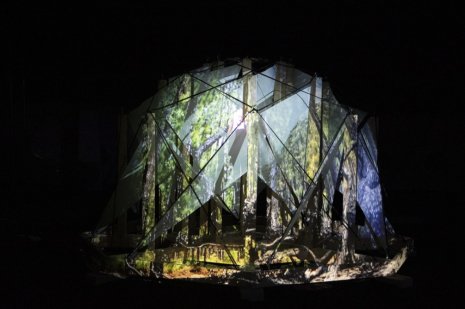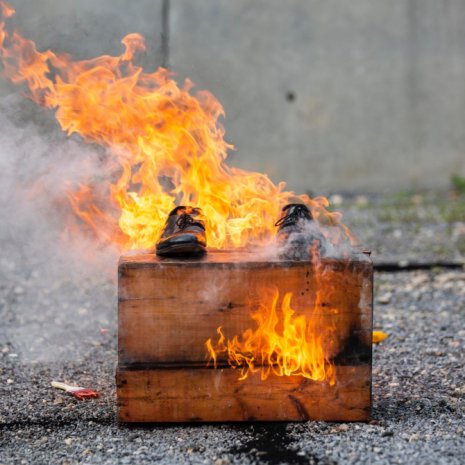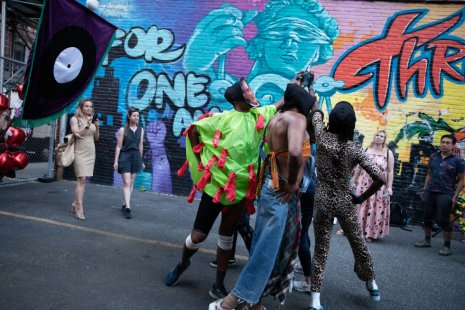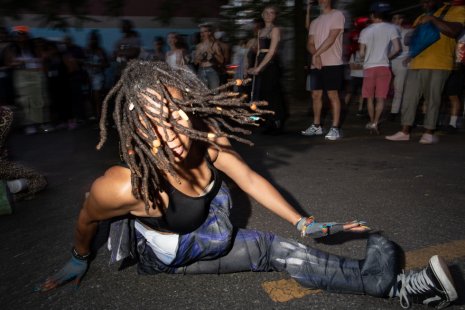In Jonathan's Words...
My work emerges at the intersections of performance which, for me, describes works for the theater, gallery, and site-specific settings as durational and evening length formats; video-art and dance for film; prose, criticism and poetry; experimental pedagogies for teaching, lecture, and curation.
I trained formally as a musician in classical opera, French horn and piano while seeking out dance waywardly at parties, performances, vogue balls, and from friends who had studio practices. My first extended opportunity to study dance occurred in high school with the Young Dancemakers Company where a cohort of teenagers were given the fundamentals to each compose and tour an original dance work in NYC alongside a learned repertory work from a collaborating dance company. That year, YDC partnered with the Merce Cunningham Company which allowed me to meet Merce and learn some of his many compositional techniques on chance as well as perform Field Dances (1963).
The work I choreographed in the program referenced my research at the time on genocide in the Congo and was selected by Dance Theater Workshop to be performed in a split bill show with Carmen De Lavallade and Gus Solomons Jr. I was quite hooked after this and continued to choreograph as part of my undergraduate studies in the humanities. My choreographic research in college allowed me to travel to London (Trinity Laban Conservatoire) and to be awarded high honors in my choreography and scholarship in performance studies. I continued this trajectory in graduate school. Upon graduating, I organized a life of performing, lighting design, and production management for artists (Will Rawls, Jaamil Olawale Kosoko, Urban Bush Women), teaching in higher education, and, all the while making work in the evenings in as many platforms for emerging artists that I could encounter in NYC.
The acceleration of this period was seminal in building my community and a sense of awareness of the specificities of Performance lineages in the Northeast US vs. different national/international contexts. Soon after finding my ground, I moved to Berlin to immerse myself in a different creative ecosystem where I primarily gigged as a performer for various artists. My home had become a triangulation between London, Warsaw, and Berlin. I had returned to Europe to experience the cultural industry, to get out of what felt like suffocating entwined constraints of American racism and American Dance, and to work with artists I had admired from afar. This period was instrumental in giving me the courage to operate at a larger scale and risk when imagining choreography.
When I returned from Europe I was able to slow down for, what felt like, the first time. I stopped performing in other artists' work and dedicated myself to a weekly studio practice. From this shift, I was able to produce the work, ZERO, with sixteen performers and three musicians which sought to fabulate on the historic slave gallows architecture in St. Marks Church in the Bowery.
From this point it became easier to trust the connections of my concerns regarding architecture, ecology, the body, racialization, abstraction, site-specificity and performance into one project. For example, works like Lucifer Landing I and II which allowed me to collaborate with members of CHARAS and their archives, PRACTICE which took us to Trinidad and US to learn Carnival techniques from the African diaspora, blues time which allowed me to explore the visual cultures of murals in Black neighborhoods, xxdjamnxx (Philly Fringe, 2023) which allowed me to re-purpose Ishmael Houston-Jones and Fred Holland’s “Wrong Contact Manifesto” score, and many more projects have been examples of my evolution as a choreographer invested in processes that convene idiosyncratic approaches to composing performance.
My short-term goals are to continue to direct performances that invite the troubled archive, the act of speculation and fabulation into the realm of Dance in manners of gesture, vibration, frequency, play, trace, subtlety... I desire to keep the scholarly life of my practice alive in and outside of the university system alongside artists, scholars, and communities in emergent pedagogies. In the long term, I would like to continue and deepen the research emerging in my recent project, sen’cer, devised during my Dance and Process residency with The Kitchen. In the longer-throw of long-term goals, I would hope to age in this practice and to continue to create contexts as an artist – whether through my current roles of artist consultation and board member seat on an arts centers or curation or informal forms of guidance – for emerging artists and dissenting practices to have a platform in the increasingly hegemonic, fascist cultural turn in the United States.
When I speak of continuity of the past, I am thinking about what remains of the past into our present(s), and how to contend with and shape our future(s). This ideological orientation comes from the queer worldings seeded by my intersecting subjectivities as well as my engagements within communities that practice this nuance (family, friends, students, collaborators, audiences, colleagues, living in the US, living in the Caribbean, living in Europe). This genre promiscuity in my creative practice is sustained and made possible with these people, in these places, and in this time.
I also rely heavily on forms of political education and study as part of my studio practice. When thinking about what remains of the past as futurity, I am referring to the fields of quantum field theory, environmentalism, geography, archaeology, black studies, media studies, and aesthetics. Many of the artists, scholars, and friends who are collaborators or sources for me in these fields help me devote myself to method. For instance: how to explore the ways that past events – like chattel slavery (ZERO, 2018), industrialization (Not Total, 2019), the human (Lucifer Landing, 2019), or touch (x2, 2021) – persists, differently, in our present, our presences (what gets housed in the body), and upon our futures. Thinking with these practitioners, about the politics of method when composing, models for me how deeply interconnected the sociopolitical, the aesthetic, the historic, the speculative and the quantum really are. I want to choreograph in flow with this radical departure from any one tradition.
My creative process readily oscillates from field work approaches (archival study, sonic-visual documentation, ethnographic methods) to studio-based practices in improvisation: I get lost within a provocation or empirical hunch, I search for the ecology of its citations — past, present, and speculative futures — I try to establish connections within this landscape of citations, I/We locate where desire and devotion are generative within this research, I/We build a prismatic relationship through what is learned using the tools of choreography, I/We let ourselves arrive somewhere unknown and listen to how it meets a public. The creative process, in general, should be a practical application of the values the project espouses. Both the process and the project should feel rigorous and transcendent all the while playful and aware of the time on the clock of the world.
Valuing the creative process and method are also, of course, political concerns. Radical Black and Indigenous feminist artists and scholars – like my mother Alba Ayme Cardona, Charmaine Lurch, Tiffany Lethabo King, Leslie Hewitt, Krista Franklin, Hortense Spillers, Sylvia Wynter, Denise Ferreira Da Silva – continue to attune me to the tentacular, interconnected nature of all matters and disciplines in the world and across space-time. They have revealed to me that constructed divisions between, for instance, the gut (a feeling) and the source (a citation), the word (speaking) and the dance (movement), the human and the subhuman, are preoccupations founded in colonial rhetoric and logic. And it is possible to re-enchant the human with faculties of being that are rooted in alignment with our desires when we practice otherwise.
In this way, what is considered the past is a question of: to whom? Others have described this somatically as “the body keeps the score.” I find my works turn to dance, sonics, speech, site, and design as meditation, and performance as a moment of temporal suspension from the imposition of what is deemed “reality.” In this moment of suspension (the performance), there is the possibility to re-enchant how we come together. Or how might we come to know what we know differently, after this? In the act of making and sharing performance, there is the opportunity for casts and audiences alike to experience moments of the sublime, of beauty, of ideological instability, within the precious container of gathering to experience. That is undeniable.











